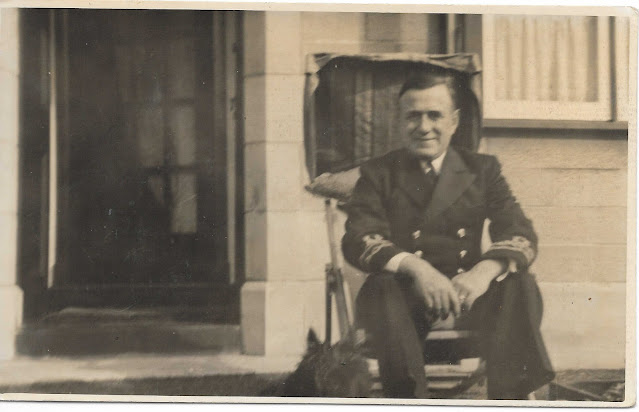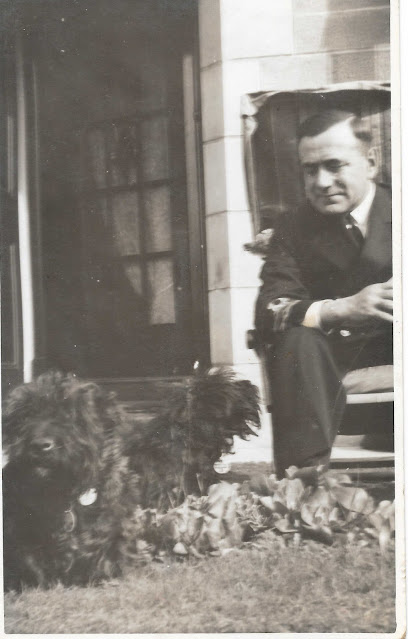William Lothian Allan
The photos of William and Margaret were originally posted by Mr Gareth Richards - many thanks, as they add so much to this profile.
William Lothian Allan was born at 6.50am on 23rd January 1899 at 34 Batson Street, Hutchesonstown.
Batson Street runs south from Aikenhead Road, with Polmadie railway depot just to the east and Cathcart Road a few blocks to the west. Number 34 is ringed in red:
Today's street view from the junction with Jamieson Street looking north to Aikenhead Road, looks very different:
Number 34 (presumably a tenement) would have been approximately in the front garden of the first house on the left.
William was the son of William John Allan (a drapery warehouseman, born in Campbelltown) and Jane (some sources say Jean) Smith (nee Russell, born in Ireland). They had married in Port Glasgow on 28th April 1898 and William was their only child.
Within a year or so, the family had moved to 6 Crow Road and they stayed there for at least the next ten years:
Number 6 is by the junction with Dumbarton Road; the goods station just north of the Allan's home is now the Crow Road shops:
Number 6 is above The Cake Gallery on the right. The beloved 'Golden Arches' are visible in the distance on the old goods station site.
By the age of 18 he was working as an apprentice engineer, and the family had moved to 260 Crow Road.
The entrance to 260 is on the left of the photo - I have included the view on the right as many motorists will recognise the junction with Clarence Drive on the left and Broomhill Drive on the right.
William joined the Royal Flying Corps on 9th November 1917. (The RFC changed its name to the Royal Air Force on 1st April 1918.) He was 5 feet and 2 inches (1.57m) and his chest was 31.5 inches; he was fairly short even by the standards of the time - the British Army had a minimum height requirement of 5 feet 3inches but formed special 'bantam battalions' of men between 5 feet and 5 feet 3 inches tall.
He must have done well because six months later he was appointed acting sergeant (albeit unpaid i.e. he did not get a rise). His record is somewhat cryptic to the layperson - I'm indebted to an expert with the user name Quemerford on The Great War Forum website for help:
RD denotes a recruit depot, fpresumably or basic training. He was then sent to Number 5 School of Aeronautics which was based at Denholm, Buckinghamshire, just outside Uxbridge on the western edge of Greater London. (The airfield's website includes a history page with some more detail of the training of an RFC pilot, click here and scroll to about halfway down the page) The final entries are training squadrons and Baldonnel was an RFC base just to west of Dublin (now Casement Aerodrome, a military base of the Irish Air Corps). He does not seem to have served with a front line unit.
Note the lack of a defined runway - biplanes bounced along the grass to take off and land. For more information in Bardonnel, click here.
William transferred to Class G reserve on 23rd March 1919 and by the time of the 1921 Census was living at 260 Crow Road with his parents. William's occupation was draughtsman engineer at Harland and Wolff shipbuilders. Harland and Wolff had two main sites in Glasgow at the time, one in Scotstoun and one in Govan, but as the former was involved in diesel engine manufacture at this time (click here), it seems reasonably certain William was working in Govan.
The view is looking back up the Clyde towards Glasgow so Govan is on the right and Princes Dock (now the SECC) is visible in the top left. The Harland and Wolff works dominate the riverfront.
There's a gap in William's story but he seems to have made a career in marine engineering as by 1932 his 'home' was on board a ship MV “British Prestige”, a recently completed oil tanker made by Lithgow’s at Port Glasgow.
We know this from his marriage certificate, to Margaret Ross Paton on 24th February 1932. Margaret was from 88 Glenhead Street, Possilpark, daughter of a house painter.
The wedding took place at what is described as the Millars Memorial Church:
The best match I can find for this is Maryhill Old Parish Church, through a link to George Millar, a trade union 'martyr' (for more information click here, it's a fascinating story!)
In the 1935 Valuation Roll for the New Kilpatrick parish, William and Marjorie were listed at a house plot (still to be built) at 9 Hillneuk Drive, Hillfoot. They must have moved in soon after as William was listed in the phone book dated 1935, phone number Bearsden 877:
(incidentally, the Bearsden telephone exchange at the time was housed in the building on Drymen Road, just south of the station, by Halford's, currently occupied by GS Properties and The Bearsden Nursery.)
By 1940 the Allans were resident there and the photo at the start of this post may have been taken outside the front door.
William was a M.I.Mar.E. (Member of the Institute of Marine Engineering) and as such would have been in demand for the RNR (Royal Navy Reserve). On 10 January 1941 he was made a temporary lieutenant (E) in the Royal Navy, the (E) denotes "engineer":
The T,124 agreement allowed experienced men from the Merchant Navy to join the Royal Navy temporarily while retaining their rates of pay and other conditions.
A young girl (at the time) remembered him as a "bright and cheerful" man who visited their house for parties when he was on leave (source, thanks to Jill Ireland).
By March 1943 he had been promoted to Lieutenant-Commander (E) and was serving on HMS Dasher, an aircraft carrier that had been built in America as a cargo ship but converted to carry a fairly limited number of aircraft. If you've never seen one before a picture probably speaks a thousand words:
This photo and the following one are taken from this excellent website, which I have based my account on; Wikipedia is unusually wobbly and contains some contradictory statements. So crudely speaking, it is still a cargo ship underneath but with a flight deck on top; the large 'hole' one the right-hand side is the lift - aircraft were stored below the flight deck and brought up on this as required.
Two Swordfish biplanes stand on the deck, the tiny figures on the deck further back towards the lift show the scale.
Dasher had seen active service in the invasion of north west Africa in November 1942 and in convoy duty but on 27 March 1943 she was in the Firth of Clyde while crews practiced taking off and landing drills.
At 16.40 the captain announced the training was over and the ship would be returning to Greenock with shore leave for the crew on this Saturday evening. The ship was about halfway between Ardrossan and Arran, on the route of today's CalMac ferry service.
Very soon after, there were two internal explosions, a smaller one, then a massive one that buckled the flight deck and blew the lift for aeroplanes into the air and over the side. The ship sank quickly, with the loss of 379 of the 528 men aboard. We don't know what happened to Lothian and, as in the case of many others, his body was never recovered.
He is officially commemorated on the Naval Memorial in Liverpool. The reason is that the T.124 scheme under which he had joined the RN was administered from there so, by convention, this is where the memorial was sited. (For Merchant Navy men who died while still in the Merchant Navy the memorial is on Tower Hill in London.)
Over 60 years later, Jill Ireland recalled the shock on Margaret's face as she told Jill's mother (her best friend) of Lothian's death.
There are memorials to the dead at Ardrossan and at Lamlash on Arran.
























Comments
Post a Comment